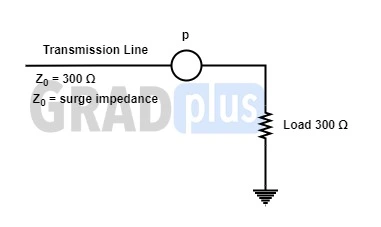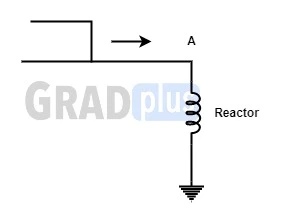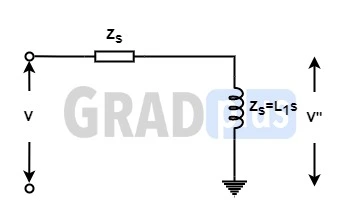Basic Concepts Power Generation and Transmission Set-1
[1996 : 2 Marks] Which material is used in controlling chain reaction in a nuclear reactor ?
(a) Thorium
(b) Heavy Water
(c) Boron
(d) Berylium
Answer : (c)
Solution : As cadmium and boron easily absorbs the slow moving neutrons, therefore, in a nuclear reactor, these two material is used for controlling chain reaction.
So, optioin (c) is the correct answer.
[2000 : 1 Mark] In a thermal power plant, the feed water coming to the economizer is heated using
(a) H.P Steam
(b) L.P. Steam
(c) Direct heat in the furnace
(d) Flue Gases
Answer : (d)
Explanation :- In economizer, feed water is preheated by using the flue gases to improve overall efficiency and only sensible heat transfer is taking place so feed water is heated without converting it into steam. Therefore, the economizer is placed after the superheater and located in the feeding water circuit.
So, option (d) is the correct answer.
[2004 : 1 Mark] In thermal power plants, the pressure in the working fluid cycle is developed by
(a) Condenser
(b) Super Heater
(c) Feed Water Pump
(d) Turbine
Answer : (c)
Solution :
Note :
Condenser : The functions of condenser are :
(i) To provide vaccum at outlet of steam turbine
(ii) To condense the steam and pass on the condensate to boiler feed
Super-heater is a device used to convert saturated steam or wet steam into dry steam used for power generation process.
[2004 : 1 Mark] For harnessing low variable water heads, the suitable hydraulic turbine with high percentage of reaction and runner adjustable vanes is
(a) Kaplan
(b) Francis
(c) Pelton
(d) Impeller
Answer : (a)
Solution :
Kaplan te works on the principle of axial flow reaction. It is used for run-of-river and poundage stations with heads of upto 70 m (low heads). This type has an axial-flow rotor with variable-pitch blades.
So, option (a) is the correct answer.
[2009 : 1 Mark] Out of the following plant categories
(i) Nuclear
(ii) Run-of-River
(iii) Pump Storage
(iv) Diesel
the base load power plants are
(a) (i) and (ii)
(b) (ii) and (iii)
(c) (i), (ii) and (iv)
(d) (i), (iii) and (iv)
Answer : (c)
Solution :
Pumped storage plants supply power-during peak loads.
Note : Base load-plant
(i) Low operating cost
(ii) Capability of working continuously long period.
[2015 : 1 Mark, Set-1] Base load power plants are
P. Wind farms
Q. Run-of-river plants
R. Nuclear Power Plants
S. Diesel Power Plants
(a) P, Q and S only
(b) P, R and S only
(c) P, Q and R only
(d) Q and R only
Answer : (c)
Solution :- Base load is the minimum level of demand on an electrical grid over a span of time. Power plants that do not change their power output quickly, such as large coal or nuclear plants, are generally called baseload power plants.
[1998 : 1 Mark] The reflection coefficient for the transmission line shown in the figure at p is

(a) +1
(b) -1
(c) 0
(d) 0.5
Answer : (c)
Solution : The reflection coefficient is equal to the ratio of the amplitude of the reflevted wave to the incident wave, with each expressed as phasors.
p_R=\frac{V_R}{V}=\left(\frac{Z_L-Z_0}{Z_L+Z_0} \right )∵ Z0 = ZL
∴ pR = 0
Therefore, option (c) is the correct answer.
[1999 : 1 Mark] An overhead line having a surge impedance of 400 Ω is connected in series with an underground cable having a surge impedance of 100 Ω. If a surge of 50 kV travels from the line towards the cable junctions, the value of the transmitted voltage wave at the junction is
(a) 30 kV
(b) 20 kV
(c) 80 kV
(d) -30 kV
Answer : (b)
Solution :
V_T=\left[\frac{2Z_C}{Z_L+Z_C} \right ]V V_T=\left[\frac{2\times 100}{400+100} \right ]\times 50\;kV=20\;kVSo, option (b) is the correct answer.
[2004 : 1 Mark] Total instantaneous power supplied by a 3-phase AC supply to a balanced R-L load is
(a) Zero
(b) Constant
(c) Pulsating with zero average
(d) Pulsating with non-zero average
Answer : (b)
Solution : Total instantaneous power supplied by a 3 – φ AC supply to a balanced RL or RC load is always constant as it does not change with time as the instantaneous power of each phase does.
Impedance of the load
= ZL = R + jωL = |Z| ∠ θL
Where, \theta _L=tan^{-1}\left(\frac{\omega L}{R} \right )
Voltage of 3-phase supply
Va = Vm Sin ωt
Vb = Vm Sin (ωt – 120°)
Vc = Vm Sin (ωt + 120°)
I_a=\frac{V_a}{Z_L}=\frac{V_mSin\;\Omega t}{|Z|\angle\;\theta _L}=I_mSin (\Omega t-\theta_L)Where,
I_m=\frac{V_m}{|Z|}Similary,
I_b=I_mSin(\Omega t-120-\theta_L)and
I_c=I_mSin(\Omega t+120-\theta_L)Instantaneous power
= P = V_aI_a+V_bI_b+V_cI_C
P=V_mI_m\left[Sin\;\omega t.Sin\;(\omega t-\theta _L)+Sin\;(\omega t-120^{\circ})Sin\;(\omega t-120-\theta_L)+Sin\;(\omega t+120)Sin\;(\omega t+120-\theta_L)\right ] P=\frac{V_mI_m}{2}\left[Cos\;\theta_L-Cos\;(2\omega t-\theta_L) \right ]+\left[Cos\;\theta_L-Cos\;(2\omega t-240-\theta_L) \right ]+\left[Cos\;\theta_L-Cos\;(2\omega t+240-\theta_L) \right ] P=\frac{3V_mI_m}{2}Cos\phi =ConstantSo, option (b) is the correct answer.
[2005 : 1 Mark] The insulation strength of an EHV transmission line is mainly governed by
(a) Load power factor
(b) Switching over-voltages
(c) Harmonics
(d) Corona
Answer : (b)
Solution :
At transmission line voltages upto around 230 kV, the insulation level is dictated by the requirement of protection against lightning. For voltages from 230 kV to 700 kV, both switching transient and lightning over voltages must be
accounted for in deciding the insulation levels. In EHV (> 700 kV) switching surges cause over voltages than lightning and are therefore mainly responsible for insulation level decision.
Option (b) is the correct answer.
[2010 : 1 Mark] Consider a step voltages wave of magnitude 1 p.u. travelling along a lossless transmission line that terminates in a reactor. The voltage magnitude across the reactor at the instant the travelling wave reaches the reactor is

(a) -1 p.u.
(b) 1 p.u.
(c) 2 p.u.
(d) 3 p.u.
Answer : (c)
Solution :

If a step voltage of magnitude ‘V’ travels through transmission line which is terminated with a inductive load ZL = L1 s then voltage transmitted (Induced) across the ZL = L1 s
V"(t)=2Ve^{-Z_st/L_1}At time t = 0
V”(t)=2 V
if V = 1
V” = 2 p.u.
So, option (c) is the correct answer.
